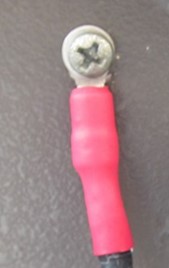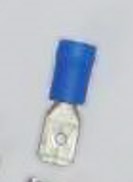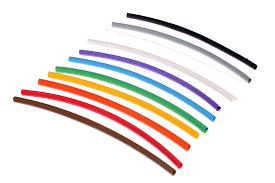Difference between revisions of "Heat Shrink Tubing"
(→Types of Heat Shrink Tubes) |
(→Types of Heat Shrink Tubes https://www.engineersedge.com/instrumentation/shrink-tubing-review.htm) |
||
| (10 intermediate revisions by the same user not shown) | |||
| Line 1: | Line 1: | ||
== Introduction == | == Introduction == | ||
| − | Heat Shrink Tubing is a | + | Heat Shrink Tubing is, in the simplest sense, a plastic tube that shrinks when heated. It is used for the insulation of wires and it provides abrasion resistance. It can also be used to bundle groups of wires, or, in some cases, provide identification.The one great feature of heat shrink tubing is that there is little or no shrinkage along the length, only shrinkage along the diameter, when heated to a specific temperature. <br \> |
| − | + | Some materials for heat shrink tubing are Polyolefin, PTFE, Viton, Silicone Rubber and PVC, of which polyolefin is the most commonly used. <ref name = "ref1">http://www.jttproducts.com/jt-t-tech-articles/An-Introduction-to-Heat-Shrink-Tubing</ref> | |
| − | |||
| − | === Single v/s Dual Heat Shrink === | + | === Single v/s Dual Heat Shrink <ref name = "ref1"/> === |
| − | '''Single / Thin wall tubing''' is the most common. This tubing provides a good seal against water and other contaminants. | + | '''Single / Thin wall tubing''' is the most common. This tubing provides a good seal thereby providing protection against water and other contaminants. Connections are also strengthened, decreasing the chances of them pulling apart. However it does not bond with the material it shrinks to. The strength is increased by friction only. <br \> |
| − | '''Dual Wall''' or | + | '''Dual Wall''' or adhesive Lined tubing features an adhesive lining, which melts as the tubing contracts forming a truly sealed connection. Thus, here a bond is established with the material the tube shrinks to. It drastically increases the strength of connections, taking it beyond the strength of the wires themselves. |
| − | === | + | === Applications <ref name = "ref1"/> === |
Heat Shrink tubing has many uses. Some are listed below: | Heat Shrink tubing has many uses. Some are listed below: | ||
| − | * | + | * It protects against water and other contaminants. |
| − | * | + | * It provides electrical insulation. Heat shrink material is an insulator. |
| − | * | + | * It protects against extreme heat. |
| − | * | + | * It can be used for identification if the tubing is color coded. |
| − | * | + | * It can help to bundle multiple wires together. |
| − | * | + | * It helps cleanly terminate ends of braided sleeving |
| − | * | + | * It helps improve the aesthetics of large amounts of wiring |
===Why should we use heat shrink tubing instead of traditional insulation? === | ===Why should we use heat shrink tubing instead of traditional insulation? === | ||
| − | + | As explained above, heat shrink tubing increases strength, providing increased durability, and also improves heat resistance. Therefore, in most cases, it performs better than basic insulation. Additionally, heat shrink tubing does not come off with age or use, and it made to provide perfect fit (which cannot be said for electrical tape). | |
| − | Heat shrink tubing is also generally easy to install. Some | + | Heat shrink tubing is also generally easy to install. Some can be installed manually, but some require extra machinery. <ref name = "ref2">http://ramproducts.com/6-things-need-know-heat-shrink-tubing/</ref> |
---- | ---- | ||
'''Additional Information''' <br \> | '''Additional Information''' <br \> | ||
| − | Heat shrink tubing was invented by Raychem Corporation. It is manufactured from a thermoplastic material such as polyolefin, fluoropolymer (such as FEP, PTFE or Kynar), PVC, neoprene, silicone elastomer or Viton. <br \> | + | Heat shrink tubing was invented by Raychem Corporation. It is manufactured from a thermoplastic material such as polyolefin, fluoropolymer (such as FEP, PTFE or Kynar), PVC, neoprene, silicone elastomer or Viton.<ref>https://en.wikipedia.org/wiki/Heat-shrink_tubing</ref> <br \> |
| − | The material is often cross-linked | + | The material is quite often cross-linked using electron beams, peroxides, or moisture. This helps creates the memory in the tubing which helps it shrink back to its original dimensions after heating. <ref name = "ref1"/> |
== Heat Shrink Insulated Terminals == | == Heat Shrink Insulated Terminals == | ||
| − | + | Heat shrink terminals offer better performance than standard crimp terminals. After crimping, the shrink sleeve is warmed and shrunk down onto the cable. It is hot metal glue lined. Thus, the mechanical strength of the termination is increased and its resistance to corrosion rises as well. The melted glue effectively seals the joint.<ref>https://www.autoelectricsupplies.co.uk/product_list/9</ref><br \> | |
| − | + | An image for female insulated terminals can be found [https://www.autoelectricsupplies.fr/product/64/category/9 here]. | |
| − | [[File: | + | [[File:HeatShrink4.jpg|thumb|left|Ring Terminals. Image reproduced from [http://www.tizianoniero.it/projects/focuser/Focuser.aspx here]]] |
| − | [[File: | + | [[File:Heat Shrink3.jpg|frame|center|Male Terminals. Attribution: CC BY-SA 3.0, https://commons.wikimedia.org/w/index.php?curid=3222351]] |
<br \> | <br \> | ||
| − | == Buying Heat Shrink Tubes == | + | == Buying Heat Shrink Tubes <ref name = "ref2" /> == |
| − | Heat shrink tubing | + | Heat shrink tubing is available in a variety of colors and sizes. It also comes with a wide range of protection levels, including heavy wall, multiple wall, and single wall. <br \> |
| − | Here are some | + | Here are some parameters you should consider if you’re buying heat shrink tubing: |
| − | * '''Maximum diameter of your cable bundle:''' This will help you choose the | + | * '''Maximum diameter of your cable bundle:''' This will help you choose the right size of your tubing. Remember, your tubing has to go over your wire before melting. |
| − | * '''Temperature range of your environment :''' | + | * '''Temperature range of your environment :''' Depending on this, you will choose tubing having a high operational temperature range, or a lower range. |
| − | * '''Wall thickness:''' | + | * '''Wall thickness:''' Typically, heat shrink tubing is categorized by heavy wall, multiple wall, and single wall tubes. Thicker walls have a higher cost and can thicken your cables, but provide improved durability, abrasion resistance and rigidity. |
| − | * '''Required resistance properties:''' | + | * '''Required resistance properties:''' If your wires may be exposed to oils or chemicals, you would require your tubing to have chemical and oil resistance properties. |
It’s also a good idea to buy heat shrink tubing that is slightly longer than you need. When heat is applied, you’ll notice that the tubing slightly shrinks lengthwise as well as widthwise, though ideally they are expected to shrink only along the diameter. | It’s also a good idea to buy heat shrink tubing that is slightly longer than you need. When heat is applied, you’ll notice that the tubing slightly shrinks lengthwise as well as widthwise, though ideally they are expected to shrink only along the diameter. | ||
---- | ---- | ||
| − | '''Additional Information''' <br \> | + | '''Additional Information''' <ref name = "ref2" /><br \> |
Heat shrink tubing comes with a range of different ratios. You’ll see these ratios advertised directly on heat shrink product descriptions or packaging. Here are the most common ratios and their uses: <br \> | Heat shrink tubing comes with a range of different ratios. You’ll see these ratios advertised directly on heat shrink product descriptions or packaging. Here are the most common ratios and their uses: <br \> | ||
| − | '''2:1 ratio:''' These tubes shrink to half | + | '''2:1 ratio:''' These tubes shrink to half their original size when heat is applied <br \> |
| − | '''3:1 ratio:''' These tubes shrink to one third of | + | '''3:1 ratio:''' These tubes shrink to one third of their original size when heat is applied |
| − | + | == Types of Heat Shrink Tubes <ref>https://www.engineersedge.com/instrumentation/shrink-tubing-review.htm</ref> == | |
| − | == Types of Heat Shrink Tubes == | + | [[File:HeatShrink.png|thumb|Colored heat shrink tubes. Image reproduced from [https://commons.wikimedia.org/wiki/File:Heat-shrink_tubing.jpg here]]] |
| − | [[File:HeatShrink.png|thumb|Image reproduced from [https://commons.wikimedia.org/wiki/File:Heat-shrink_tubing.jpg here]]] | ||
=== Elastomeric Tubes === | === Elastomeric Tubes === | ||
| − | + | These tubes maintain high flexibility even at low temperatures. They also meet stringent international specifications. Their operating temperature range is -75 to 150 °C, which is sufficiently wide. A common shrink ratio is 2:1. | |
=== Fluorinated Ethylene Propylene (FEP) === | === Fluorinated Ethylene Propylene (FEP) === | ||
| − | It | + | It is inert to most chemicals and solvents. Additionally, it is very resistant to extreme levels of heat, cold, and ultraviolet radiation, thereby making it an excellent material for heat-shrink tubing applications. |
=== Polyolefin Tubes === | === Polyolefin Tubes === | ||
| − | + | These, as mentioned above, are most commonly used heat shrinktubes and have maximum use for temperatures from -55 to 135 °C, and are used by the military, aerospace and railway industries. They are manufactured in a wide range of colors (including clear), which can be used for color-coding wires. Polyolefin tubing shrinks at 143°C. Polyolefin heat-shrink tubing typically shrinks 2:1 diametrically, but there are high-grade polyolefin tubes also available with a 3:1 ratio. Interestingly, polyolefin tubing may survive being touched with a soldering iron. | |
| − | |||
| − | |||
| − | |||
| − | |||
| − | |||
---- | ---- | ||
If you are done reading this page, you can go back to [[Mechanical Subsystem]] | If you are done reading this page, you can go back to [[Mechanical Subsystem]] | ||
| + | |||
| + | == References == | ||
Latest revision as of 10:57, 23 February 2018
Contents
Introduction
Heat Shrink Tubing is, in the simplest sense, a plastic tube that shrinks when heated. It is used for the insulation of wires and it provides abrasion resistance. It can also be used to bundle groups of wires, or, in some cases, provide identification.The one great feature of heat shrink tubing is that there is little or no shrinkage along the length, only shrinkage along the diameter, when heated to a specific temperature.
Some materials for heat shrink tubing are Polyolefin, PTFE, Viton, Silicone Rubber and PVC, of which polyolefin is the most commonly used. [1]
Single v/s Dual Heat Shrink [1]
Single / Thin wall tubing is the most common. This tubing provides a good seal thereby providing protection against water and other contaminants. Connections are also strengthened, decreasing the chances of them pulling apart. However it does not bond with the material it shrinks to. The strength is increased by friction only.
Dual Wall or adhesive Lined tubing features an adhesive lining, which melts as the tubing contracts forming a truly sealed connection. Thus, here a bond is established with the material the tube shrinks to. It drastically increases the strength of connections, taking it beyond the strength of the wires themselves.
Applications [1]
Heat Shrink tubing has many uses. Some are listed below:
- It protects against water and other contaminants.
- It provides electrical insulation. Heat shrink material is an insulator.
- It protects against extreme heat.
- It can be used for identification if the tubing is color coded.
- It can help to bundle multiple wires together.
- It helps cleanly terminate ends of braided sleeving
- It helps improve the aesthetics of large amounts of wiring
Why should we use heat shrink tubing instead of traditional insulation?
As explained above, heat shrink tubing increases strength, providing increased durability, and also improves heat resistance. Therefore, in most cases, it performs better than basic insulation. Additionally, heat shrink tubing does not come off with age or use, and it made to provide perfect fit (which cannot be said for electrical tape). Heat shrink tubing is also generally easy to install. Some can be installed manually, but some require extra machinery. [2]
Additional Information
Heat shrink tubing was invented by Raychem Corporation. It is manufactured from a thermoplastic material such as polyolefin, fluoropolymer (such as FEP, PTFE or Kynar), PVC, neoprene, silicone elastomer or Viton.[3]
The material is quite often cross-linked using electron beams, peroxides, or moisture. This helps creates the memory in the tubing which helps it shrink back to its original dimensions after heating. [1]
Heat Shrink Insulated Terminals
Heat shrink terminals offer better performance than standard crimp terminals. After crimping, the shrink sleeve is warmed and shrunk down onto the cable. It is hot metal glue lined. Thus, the mechanical strength of the termination is increased and its resistance to corrosion rises as well. The melted glue effectively seals the joint.[4]
An image for female insulated terminals can be found here.


Buying Heat Shrink Tubes [2]
Heat shrink tubing is available in a variety of colors and sizes. It also comes with a wide range of protection levels, including heavy wall, multiple wall, and single wall.
Here are some parameters you should consider if you’re buying heat shrink tubing:
- Maximum diameter of your cable bundle: This will help you choose the right size of your tubing. Remember, your tubing has to go over your wire before melting.
- Temperature range of your environment : Depending on this, you will choose tubing having a high operational temperature range, or a lower range.
- Wall thickness: Typically, heat shrink tubing is categorized by heavy wall, multiple wall, and single wall tubes. Thicker walls have a higher cost and can thicken your cables, but provide improved durability, abrasion resistance and rigidity.
- Required resistance properties: If your wires may be exposed to oils or chemicals, you would require your tubing to have chemical and oil resistance properties.
It’s also a good idea to buy heat shrink tubing that is slightly longer than you need. When heat is applied, you’ll notice that the tubing slightly shrinks lengthwise as well as widthwise, though ideally they are expected to shrink only along the diameter.
Additional Information [2]
Heat shrink tubing comes with a range of different ratios. You’ll see these ratios advertised directly on heat shrink product descriptions or packaging. Here are the most common ratios and their uses:
2:1 ratio: These tubes shrink to half their original size when heat is applied
3:1 ratio: These tubes shrink to one third of their original size when heat is applied
Types of Heat Shrink Tubes [5]

Elastomeric Tubes
These tubes maintain high flexibility even at low temperatures. They also meet stringent international specifications. Their operating temperature range is -75 to 150 °C, which is sufficiently wide. A common shrink ratio is 2:1.
Fluorinated Ethylene Propylene (FEP)
It is inert to most chemicals and solvents. Additionally, it is very resistant to extreme levels of heat, cold, and ultraviolet radiation, thereby making it an excellent material for heat-shrink tubing applications.
Polyolefin Tubes
These, as mentioned above, are most commonly used heat shrinktubes and have maximum use for temperatures from -55 to 135 °C, and are used by the military, aerospace and railway industries. They are manufactured in a wide range of colors (including clear), which can be used for color-coding wires. Polyolefin tubing shrinks at 143°C. Polyolefin heat-shrink tubing typically shrinks 2:1 diametrically, but there are high-grade polyolefin tubes also available with a 3:1 ratio. Interestingly, polyolefin tubing may survive being touched with a soldering iron.
If you are done reading this page, you can go back to Mechanical Subsystem
References
- ↑ 1.0 1.1 1.2 1.3 http://www.jttproducts.com/jt-t-tech-articles/An-Introduction-to-Heat-Shrink-Tubing
- ↑ 2.0 2.1 2.2 http://ramproducts.com/6-things-need-know-heat-shrink-tubing/
- ↑ https://en.wikipedia.org/wiki/Heat-shrink_tubing
- ↑ https://www.autoelectricsupplies.co.uk/product_list/9
- ↑ https://www.engineersedge.com/instrumentation/shrink-tubing-review.htm